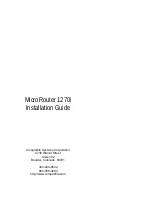
Chapter 2 - Getting Started
7
Ethernet Connection Requirements
The MicroRouter 1270i’s Ethernet interfaces directly support 10BaseT
twisted-pair Ethernet. Other Ethernet cabling types (such as thin
Ethernet, thick Ethernet, fiber optic cabling or pre-10BaseT
twisted-pair) can be supported using a 10BaseT mini-hub or other
conversion device.
10Base-T Twisted-Pair Ethernet
To connect the router's Ethernet interface to twisted-pair Ethernet
cabling you will need an unshielded twisted-pair station cable that is
connected to a 10BaseT-compatible twisted-pair hub.
v
Note:
Ethernet cables and cable connectors are not supplied with
the MicroRouter product. Please contact your reseller or your
Compatible Systems representative for information on obtaining the
correct Ethernet cabling supplies.
T1 Line Connection Requirements
The MicroRouter 1270i includes an integrated fractional or full T1
CSU/DSU. To connect this interface to a T1 line, you will need an
RJ-45 jumper cable. A straight-through Category 5 10BaseT jumper
cable will work in this application.
v
Note:
The MicroRouter 1270i includes loopback features which can
be used to check the functionality of your T1 line. Before attempting to
route network traffic, use these features to check the line’s basic
integrity.
Other Telco Line Connection Requirements
In order to connect to non-T1 wide area transmission lines, you must
connect the router’s secondary wide area port to a modem, 56K
CSU/DSU, or ISDN Terminal Adapter. Which of these devices you use
depends on the type of telco line.
v
Note:
Before attempting to connect the MicroRouter 1270i’s
secondary port to a leased telco line, use the loopback features of your
external CSU/DSU to check the line. This can save you a considerable
amount of time, since the more equipment you have on the line, the more
difficult it becomes to determine where a problem is occurring.














































